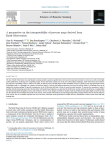Watmough G.R., Brockington D., Marcinko C.L.J., Hall O., Pritchard R., Berchoux T., Gibson L., Delamonica E., Boyd D., Mlambo R., O Héir S., Seth S. (2025). A perspective on the interpretability of poverty maps derived from Earth Observation. Science of Remote Sensing, 01/12/2025, vol. 12, p. 100298.
https://doi.org/10.1016/j.srs.2025.100298
https://doi.org/10.1016/j.srs.2025.100298
| Titre : | A perspective on the interpretability of poverty maps derived from Earth Observation (2025) |
| Auteurs : | G.R. Watmough ; D. Brockington ; C.L.J. Marcinko ; O. Hall ; R. Pritchard ; T. Berchoux ; L. Gibson ; E. Delamonica ; D. Boyd ; R. Mlambo ; S. O Héir ; S. Seth |
| Type de document : | Article |
| Dans : | Science of Remote Sensing (vol. 12, December 2025) |
| Article en page(s) : | p. 100298 |
| Langues : | Anglais |
| Langues du résumé : | Anglais |
| Catégories : |
Catégories principales 14 - SOCIOLOGIE ; 14.1 - Généralités et ThéorieThésaurus IAMM CARTOGRAPHIE ; PAUVRETE ; METHODE D'OBSERVATION ; ANALYSE DE DONNEES ; MODELE ; TECHNIQUE D'IMAGERIE ; TELEDETECTION |
| Résumé : | The use of Earth Observation Data and Machine Learning models to generate gridded micro-level poverty maps has increased in recent years, with several highprofile publications. producing some compelling results. Poverty alleviation remains one of the most critical global challenges. Earth Observation (EO) technologies represent a promising avenue to enhance our ability to address poverty through improved data availability. However, global poverty maps generated by these technologies tend to oversimplify the complex and nuanced nature of poverty preventing progression from proof-of-concept studies to technology that can be deployed in decision making. We provide a perspective on the EO4Poverty field with a focus on areas that need attention. To increase the awareness of what is possible with this technology and reduce the discomfort with model-based estimates, we argue that the EO4Poverty models could and should focus on explainability and operationalizability alongside accuracy and robustness. The use of raw imagery in black-box models results in predictions that appear highly accurate but that are often flawed when investigated in specific local contexts. These models will benefit for incorporating interpretable geospatial features that are directly linked to local context. The use of domain expertise from local end users could make model predictions accessible and more transferable to hard-to-reach areas with little training data. |
| Cote : | Online |
| URL / DOI : | https://doi.org/10.1016/j.srs.2025.100298 |
Documents numériques (1)
PRO53753.pdf Adobe Acrobat PDF |







